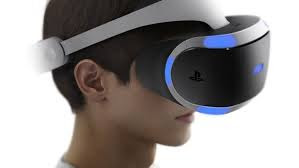Imagine the possibility of being joined by a foreign exchange student virtually; or, going into the human system to better understand the different functions. Or even better, being able to view organic chemistry and what the structures actually mean.
While those are still far away. So, let us review the options that are available now in terms of VR products.
Oculus Rift
 |
| Photo by Oculus of latest Oculus Rift to be released |
This is the product which restarted the mass scale interest in VR after the 90’s fiasco. It has been attempted before, but limitations in technology held the products back in realizing their true potential. First released in late 2012, the DK1 was immensely successful and they were able to raise the minimum amount for their campaign very easily. Their DK2 launched in 2014 was of similar success and now, the final product is set for release in Q1 of 2016. Although, an official price has not been announced yet, it will be between $200-400 USD. It will have 1080p resolutions and an external tracking device included in the package.
Project Morpheus/PlayStation VR
This is not the first venture of Sony into VR; Sony released a VR Headset back in 1997 named Glasstron, but it wasn't successful. However, the public came to know about its latest venture in 2014, when R&D team released info on a new VR headset, which had been in the works for 3 years already. The expected date of release is also somewhere in the Q1 of 2016, but unlike Oculus there has not been an official announcement yet. This VR boasts 2k HD displays each and a separate one for the TV. It has the added advantage of being compatible with its existing gaming system.
HTC Vive: Steam VR
This is one of the later ventures by HTC into VR space. It was announced in 2015 and was rumored to be ready by the end of 2015, but the release has been subsequently shifted to next year as well. Steam VR offers some cool features as well. It has a built in microphone and a tracking system which can track your movements across a 15ft by 15ft room. This also features 1080p resolution on each display. In terms of immersion, this is perhaps the top rated of the 3, yet.
Samsung Gear VR
This is the result of a partnership between Samsung and Oculus. It converts select Samsung phones into mobile VR units. The result is that you can get a balanced taste of VR. Meanwhile various app developers have released games for this platform. It has an official price tag of $99 and is currently available in the market.
Google Cardboard
Google being Google, released its own VR headset; albeit a cheap one which can be printed and made at home with just a few items. It turns any smartphone into a basic VR headset. The quality depends on the resolution of the screen. However, it was an ingenious addition, which has helped the VR industry by providing cheap access to developers and general public, so that they have a better idea about the actual products. Google is no longer making these kits, but many third parties approved by Google are still churning these out.
With fingers crossed, we all await some new consumer products to be launched in the VR sector; however, the current experiences are enough to proclaim that even those finished products will be just the first step. There are still issues such as nausea upon use, due to human brain’s hardcoded mechanisms against jerky movements. However, competition is always a healthy sign; and many game developers are making games specifically for this tech. Third party companies are also working on accessories that would make the whole experience more immersive. These range from motion controllers to special treadmills, so that the limitations of wired play can be countered. The future is definitely bright for it as a whole and hopefully, the kinks will be ironed out before their final release.











